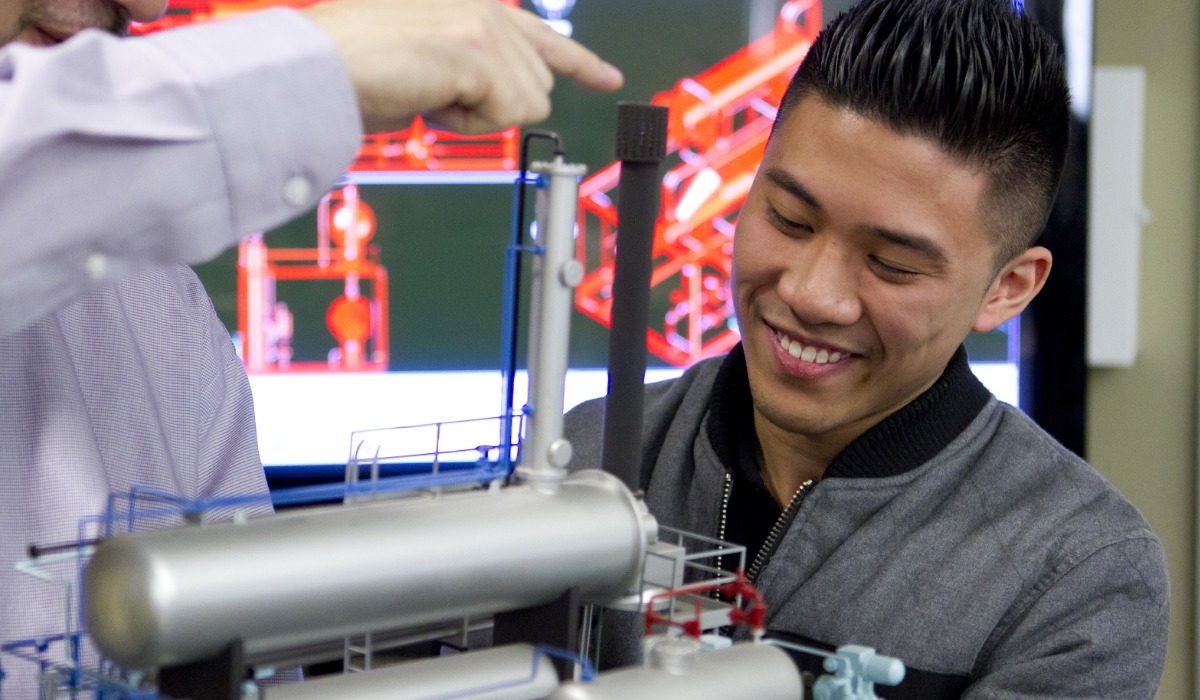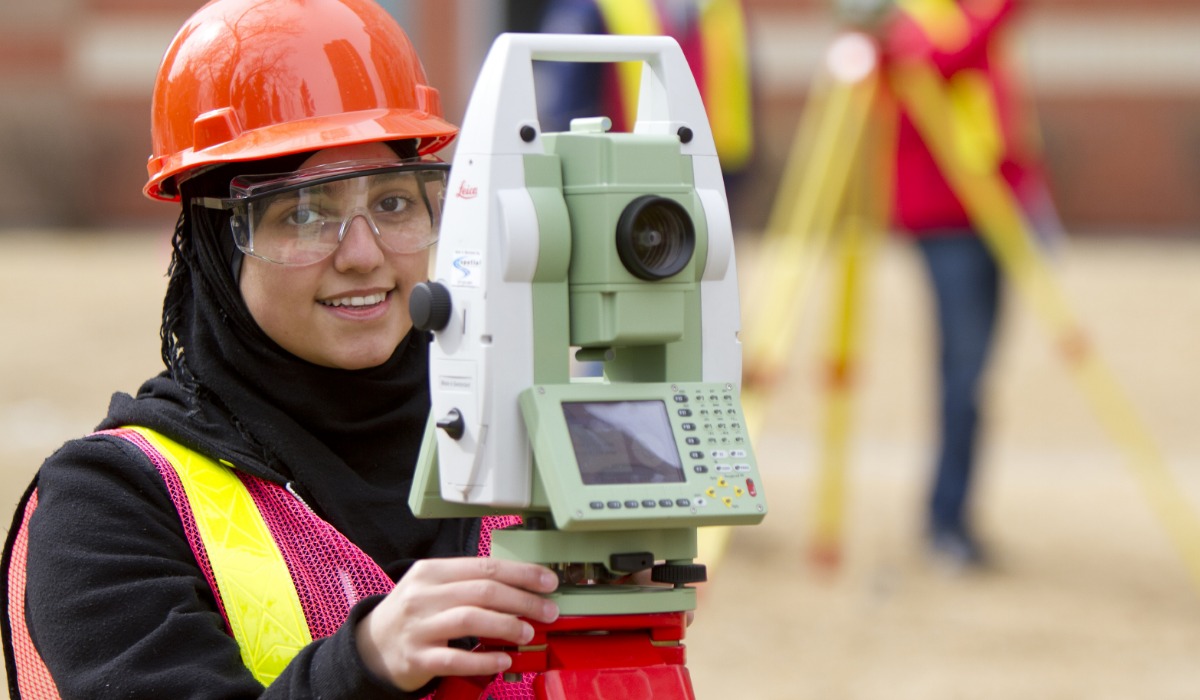Overview
Architectural Technologies is crafted to empower you with the skills and knowledge to excel as an architectural technologist.
This program caters to the evolving demands of architectural firms, residential builders, and the broader construction industry, providing a solid foundation for a career in architectural design and construction.
This two-year program emphasizes project-based learning that mirrors real-world architectural practices, with access to state-of-the-art technology and software used in the industry. You will develop critical thinking and practical skills focusing on integrating theory with hands-on application.
You will learn:
- the science and practice of architectural technology through a mix of lectures, labs, and collaborative projects
- how to navigate and apply building codes, bylaws, and regulations effectively
- advanced skills in building science and building systems
- proficiency in 3D and 4D Building Information Modeling (BIM) for various project stages
- project management, including costing, scheduling, proposal development, and documentation.
As a graduate, you'll be prepared for roles such as architectural technologist, BIM coordinator, or project manager. You'll have had the opportunity to build a portfolio of work demonstrating competencies to potential employers.
If you're interested in the intersection of architecture, technology, and construction or are seeking a career change or advancement in the field of architectural technology, this SAIT program is for you.
Architectural technologists are innovative, methodical and objective.
You need:
- high moral and ethical standards
- precision, persistence, and accuracy
- an interest in design and aesthetics
- an aptitude for math and science
- spatial awareness
- the ability to see objects in 3D
- graphic, oral, and written communication skills
- the ability to work well under pressure to meet deadlines
- proficiency in architectural drawing/rendering software
- the ability to generate 3D renderings for presentation purposes
- knowledge of applicable building codes and zoning regulations.
You should enjoy working with a team, analyzing and finding solutions to problems, taking a systematic approach to your work, and using instruments and equipment for precision tasks.
Throughout the program, you'll engage in individual and team projects each semester.
In the final semester of this program, you'll participate in a capstone project with the support of a coach or mentor, where you'll implement all the skills you've acquired to solve a real-world problem.
Upon successfully completing this program, you'll receive a SAIT Architectural Technologies diploma.
Careers and opportunities
Each year, SAIT conducts a survey between February and April to determine the employment rate, salary and satisfaction of our newest SAIT alumni.
![]() 84% graduate employment rate
84% graduate employment rate
![]() $52,000 average starting salary
$52,000 average starting salary
Find out more about our graduate employment statistics >
Our graduates may work in the following occupations. Some careers require additional experience and education.
Associated National Occupational Classification (NOC) codes: 20011, 21200, 21300, 22210, 22212, 22233, 22300, 22303, 70011.
Career planning support
Unsure which career path is for you? Here are some recommended career planning resources to help you decide your future.
You can also head to Alberta alis for lots of information about careers in Alberta, including quizzes and labour market information to help you narrow down a path.
Finally, you can take our online career finder quiz, which can help narrow your options based on your current skills and interests.
Courses
The Architectural Technologies diploma requires 60 credits (20 courses) to complete.
The program spans two years, with two semesters each year.
| Course | Credits |
|---|---|
|
This course is an introduction to essential aspects of the regulations, contracts, codes and costing pertaining to a small scale structure. Students will learn how to navigate, analyze, interpret and apply technical provisions as outlined in relevant building codes and municipal bylaws following industry standards. Additionally, students will explore product research and costing strategies. |
3 |
|
In this introductory course, students learn how to identify, determine and integrate a variety of industry-standard building systems pertaining to residential construction. Students will learn relevant principles in order to effectively explore, refine and resolve problems in building systems and science. Additionally, students will learn characteristics of common building materials; their properties, manufacture, and installation. Students will produce drawings and analysis for a building project. |
3 |
|
This course is an introduction to the purpose, practice and scope of architectural drawing, representation and visualization. Students will learn various graphic drawing languages, fundamental tools and media used in industry. Students will learn how to identify, navigate, analyze, interpret and apply technical provisions as they pertain to the basic design and drafting of a simple residential project. Students will produce partial documentation for a small structure following industry standards. |
3 |
|
In this course students learn to develop, document and defend an architectural design. The student will be able to synthesize an architectural design that considers historical, social and functional intent. The learner will devise, systematize, and specify critical technical solutions to an architectural design, in order to defend a design choice. This course will encourage the student to explore the creative process of design through a series of reading, investigation, and analysis of ideas in architectural form and relationships. |
3 |
|
In this course students will apply more complex principles with the intent of integrating factors such as site influences, building systems and material choices into a final project. Aspects of sustainability are identified and mechanical systems are introduced. Competent architectural detailing is emphasized. Pre-requisites:
|
3 |
|
This course expands on the foundation set up in Documents and Regulations I. Similar to the foundation course students will study further aspects of the regulations, codes, and bylaws related to architectural projects. In this course, Documents and Regulations II, students examine the documentation involved in a project such as contracts, materials lists, estimates and reports. The coursework will again be directed at a semester project in which the student will incorporate the basic elements from the semester 1 project and integrate the new concepts and learnings from this course into a project. Pre-requisites:
|
3 |
|
This course advances the knowledge that students gained in Technology I. Students are introduced to Building Information Modeling (BIM). The concept and application of the interoperability between different software platforms is an emphasis. Students will produce partial documentation for a building project. Pre-requisites:
|
3 |
|
In this course, students will elaborate and refine the skills learned in the first semester on structures and apply them to the concept of small mixed-use projects. Students will examine architectural case studies as they pertain to precedents and the evolution of small mixed-use projects. Greater emphasis will be placed on students identifying and resolving design issues and representing work to stakeholders through graphics and presentations. Pre-requisites:
|
3 |
|
Students will learn how to apply regulations, codes, and bylaws to commercial construction. Material covered includes further studies of fire safety, multiple occupancy requirements; building size and occupancy requirements; spatial separation and means of egress and exits for commercial projects. Contract documents and contract administration provides an insight into the commercial construction process from "cradle to grave". Pre-requisites:
|
3 |
|
Students expand the scale and scope of science and systems to light industrial and commercial systems. Application in this course will focus on more complex building systems, higher building performance, intensive systems integration and exact product specification. Critical thinking and the ability to synthesize multi-faceted problems are paramount. In this course students will establish an integrated foundation of skills as they relate to commercial buildings. These skills will provide the framework to represent architectural intentions for stakeholders to understand and use. Pre-requisites:
|
3 |
|
This course builds on the Building Information Modeling (BIM) knowledge gained in the previous course and applies it in a commercial or light industrial setting. Students will learn intermediate and advanced techniques to gain deeper control of the BIM environment. Students will use this knowledge to produce documentation for a modest commercial or industrial project. Pre-requisites:
|
3 |
|
Design principles and methodology are applied to commercial structures by analyzing client needs, site considerations, case studies and schematic design. The design process will be similar to semester two though the task at hand will be more complex. Emphasis will be placed on representing the work to stakeholders. This course will guide students through the additional complexities of a commercial structure. Pre-requisites:
|
3 |
|
This course examines the various considerations and components which interact with building systems. The student will not only determine how best to integrate building systems with each other but also consider the sustainability and resilience of building systems. The student will explore new technologies in building systems and perform simulations to determine the design of the final semester project. Pre-requisites:
|
3 |
|
In this course, students will expand their knowledge of the tools and technologies explored in the previous courses. They will also explore new and emerging tools and trends which can be integrated into their semester project. An integral component of this course is the use of simulation tools to test performance and refine projects. The student will be expected to use an interdisciplinary and innovative approach in their use of tools and technologies within their project. Pre-requisites:
|
3 |
|
Students will learn how to adapt and refine regulations, codes, and bylaws to a multifaceted project. Topics include the meeting the requirements of fire safety, occupancy; and safety as well as energy compliancy. Students will learn the iterative nature of contract administration, and the management of a project. Pre-requisites:
|
3 |
|
Design principles and methodology will be applied to a multifaceted project. Students will use their foundational knowledge of research and design to identify a problem and then research and develop solutions. The students will be encouraged to find viable, creative and innovative solutions. This process will be documented within the semester project from project conception, interpretation and through to realization and delivery to relevant stakeholders. Pre-requisites:
|
3 |
|
This course is designed to develop technical writing and presentation skills to ensure workplace readiness. Students will learn how to evaluate communication situations, analyze documents, assess research sources and develop organizational skills to apply in their work. They will learn about and practice designing, formatting and writing a range of professional documents. Students will also develop confidence (through practice) in the development and delivery of effective and engaging presentations. Equivalents:
|
3 |
|
Technical Mathematics I covers a variety of mathematical methods for solving problems in architectural, structural and construction applications. The study of ratios and variation, algebraic functions, and plane analytic geometry is addressed. Trigonometric, exponential, and logarithmic functions and graphs are analyzed and applied to solving problems. Systems of linear equations are solved using algebraic methods and matrices. The evaluation of limits and calculation of rates of change using first principles are also explored. Equivalents:
|
3 |
|
The capstone course is intended to encourage you to think critically and solve challenging problems. It is a course that is predominantly self-directed. Your project will develop and evolve with the supervision of a coach or mentor. The capstone project is intended to be interdisciplinary. It requires you investigate issues across many different subject areas or domains of knowledge. It should encourage you to connect your project to community issues or problems, and to integrate outside-of-school learning experiences. Your project should be unique and aim to integrate and synthesize your collective learning to date. You are allowed and expected to apply your creativity and problem solving abilities to a real world context. Capstone projects are a chance for you to demonstrate your competencies to both the faculty from which you will be graduating and to the world you hope to join. Pre-requisites:
Corequsites:
|
3 |
|
STAT 245 is an introductory course in data analysis for students in engineering technology programs. Students apply techniques to organize, display, analyze and report data. Outcomes include methods of descriptive and inferential statistics. Students will be exposed to software-based methods in laboratory sessions using industry-grade data. Some advanced topics of analysis are selectable toward the end of the course. |
3 |
Progression
You must attain a PGPA and/or a CGPA of 2.0 or better each semester and pass the prerequisite courses to progress through the program.
To qualify for graduation, you must pass all courses, attain a CGPA of 2.0 or better and complete course requirements within the prescribed timelines.
Review our grading and progression procedure >
Explore your options!
Some courses in this program are available through Open Studies. You can complete courses via Open Studies to get a head start on your education, reduce your course load once accepted into a credentialed program, or determine which career path best suits you before you fully commit.
You may also take courses for general interest or personal and professional development.
Admission requirements
Applicants educated in Canada
All applicants must demonstrate English language proficiency and meet the following requirements or equivalents:
- at least 50% in Math 30-1 or Math 30-2, and
- at least 50% in English Language Arts 30-1 or English Language Arts 30-2, and
- at least 50% in a Grade 12 Science.
SAIT accepts high school course equivalents for admission for applicants educated outside Alberta.
All applicants who were educated outside of Canada must demonstrate English language proficiency and provide proof they meet the program admission requirements outlined above with an international document assessment. Find accepted educational documents and assessment options.
SAIT may also accept courses completed at certain international post-secondary institutions.
Academic Upgrading
Missing an admission requirement for this program? Upgrade your prior education to help you receive admission into one of SAIT's career programs.
English language proficiency
All applicants must demonstrate English language proficiency prior to admission, including students educated in Canada.
Transfer agreements
At SAIT, we have created transfer agreements with partner institutions to allow you to earn course credits toward your SAIT program based on your previously completed credentials.
Transfer Alberta search tool
Use the Transfer Alberta search tool to see all transfer agreements between Alberta post-secondary institutions (including those with the University of Calgary, Mount Royal University and Bow Valley College.)
Search transfer agreements in Alberta
Transfer options for graduates
When you have completed this program, you may continue your education at a partner post-secondary institution. These transfer agreements include partnerships within and/or outside of Canada.
Credits this program transfers to
- Available credits:
- 30
Upon successful completion of this program, you'll be eligible to receive up to 30 credits (one year) toward Griffith's Bachelor of Architectural Design.
This degree is a three-year program offered on-campus beginning in February each year.
- Available credits:
- 57
Upon successful completion of this program, you can ladder into the third year of TRU's Open Learning Bachelor of Technology program, provided you meet the admission requirements.
- Available credits:
- 60
Upon successful completion of this program, you can ladder into the third year of TRU's Open Learning Bachelor of Technology: Trades and Technology Leadership program, provided you meet the admission requirements.
Available intakes
Winter 2026
Start dates:
- Domestic students: Closed
-
-
Application deadline:
-
- International students: Closed
-
-
Application deadline:
-
Fall 2026
Start dates:
- Domestic students: Open
-
-
Application deadline: June 30, 2026
-
- International students: Open
-
-
Application deadline: May 29, 2026
-
Winter 2027
Start dates:
- Domestic Students (apps open March 1, 2026): Closed
-
-
Application deadline: Oct. 23, 2026
-
- International students: Open
-
-
Application deadline: Oct. 9, 2026
-
Costs
2025/26 tuition and fees
The following costs are effective as of July 1, 2025.
The estimated total cost of tuition and fees is based on the suggested schedule of study. Following a modified schedule will impact the fees you pay per semester and may alter final costs.
Domestic students
The program total is based on the estimated amount you will pay if you enter this program during the 2025/26 academic year. The program total amount listed on your letter of admission may appear higher. This amount is your maximum tuition guarantee for the program. SAIT will not exceed this maximum, regardless of changes in tuition and fees between academic years.
Books and supplies are approximately $1,000 - $1,500 per full-time year.
This is a bring-your-own-device program with a power-user hardware and software requirement. See the specific requirements on our computers and laptops page. It must be a Windows PC. Mac-based laptops are not supported in this program.
This program doesn't require any textbooks.
Required personal protective equipment (PPE)
The industry-approved PPE you'll need will be discussed during your first few days of classes.
Financial aid
Paying for your education may feel overwhelming, but we have resources and programs that can help, including information about payment options, student loans, grants and scholarships.
Application process
Ready to apply?
Follow our step-by-step guide to submitting a successful application.
Communication during admission
Email is the primary source of communication during the selection process. Ensure your personal email account is managed appropriately to receive our emails, files and communications. We recommend you add the construction.advising@sait.ca domain to your safe senders' list or you risk missing critical email messages.
Begin your application
Apply now using the online application portal.
Ensure you have a valid Visa or Mastercard to pay the non-refundable application fee of $120 for domestic applicants or $175 for international applicants.
Information sessions
Prepare for a strong start in your chosen program or get the details you need to decide your future path.
Our expert staff and faculty are ready to answer your questions and provide information about the following:
- What sets SAIT apart
- An introduction to the program and area of study
- Admission requirements
- Future career paths
- Information on the earning potential and graduate employment rates.
Contact us
Prepare for a strong start and get the details you need to make a decision about your future. Our expert staff and faculty are ready to answer your questions, and provide information about:
School of Construction
-
Phone - 403.284.8367
International Student Advising
-
Phone - 403.284.8852
-
Email - international@sait.ca
Subscribe for updates
Your journey starts here! Sign up to get important updates on:
- Business and leadership programs
- Application information
- Relevant news and events

Oki, Âba wathtech, Danit'ada, Tawnshi, Hello.
SAIT is located on the traditional territories of the Niitsitapi (Blackfoot) and the people of Treaty 7 which includes the Siksika, the Piikani, the Kainai, the Tsuut’ina and the Îyârhe Nakoda of Bearspaw, Chiniki and Goodstoney.
We are situated in an area the Blackfoot tribes traditionally called Moh’kinsstis, where the Bow River meets the Elbow River. We now call it the city of Calgary, which is also home to the Métis Nation of Alberta.




